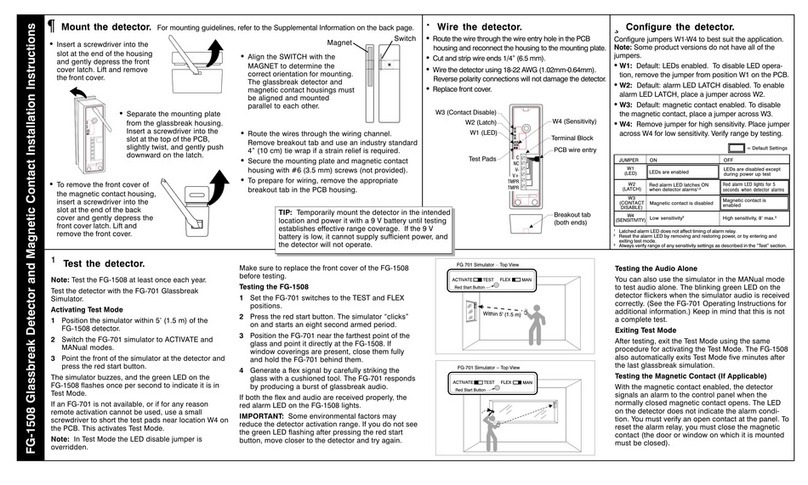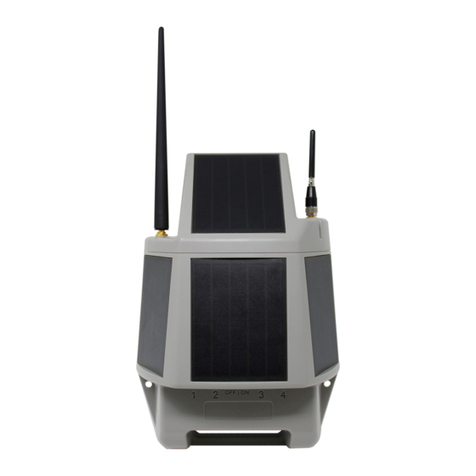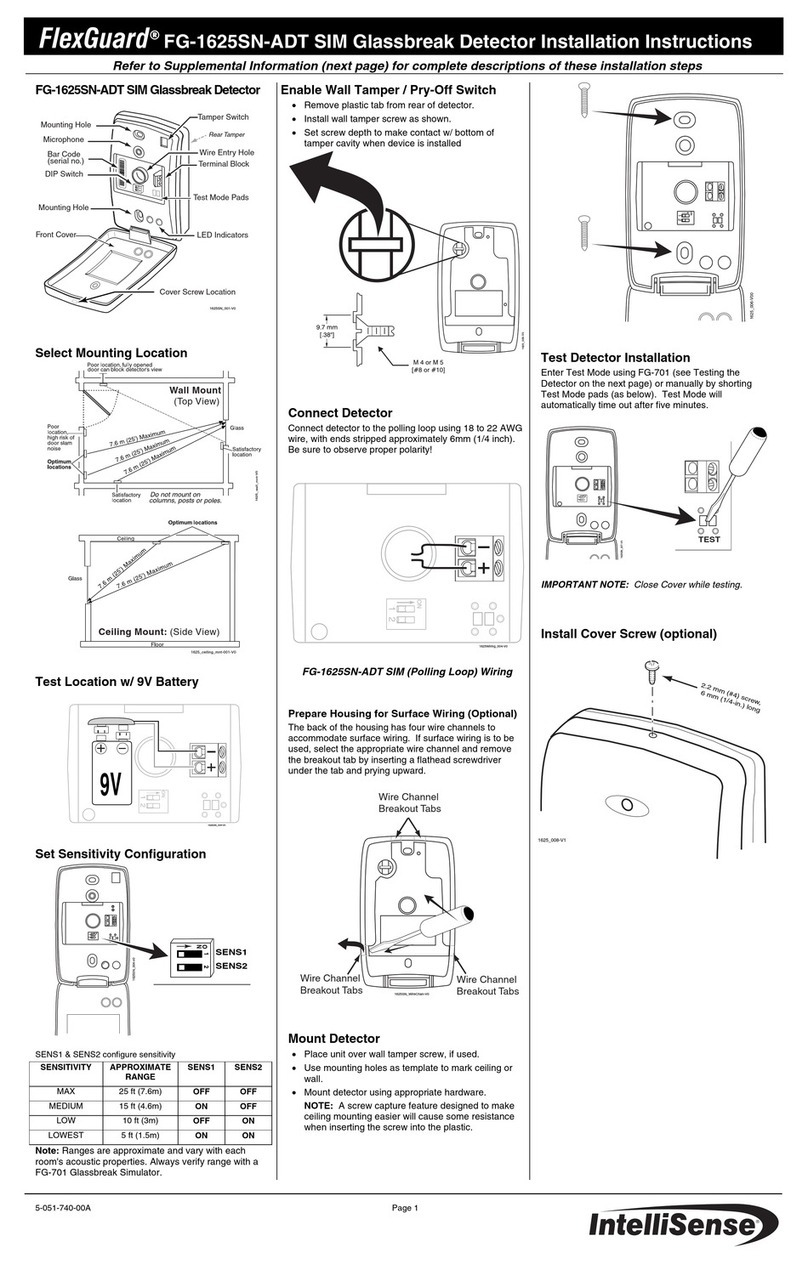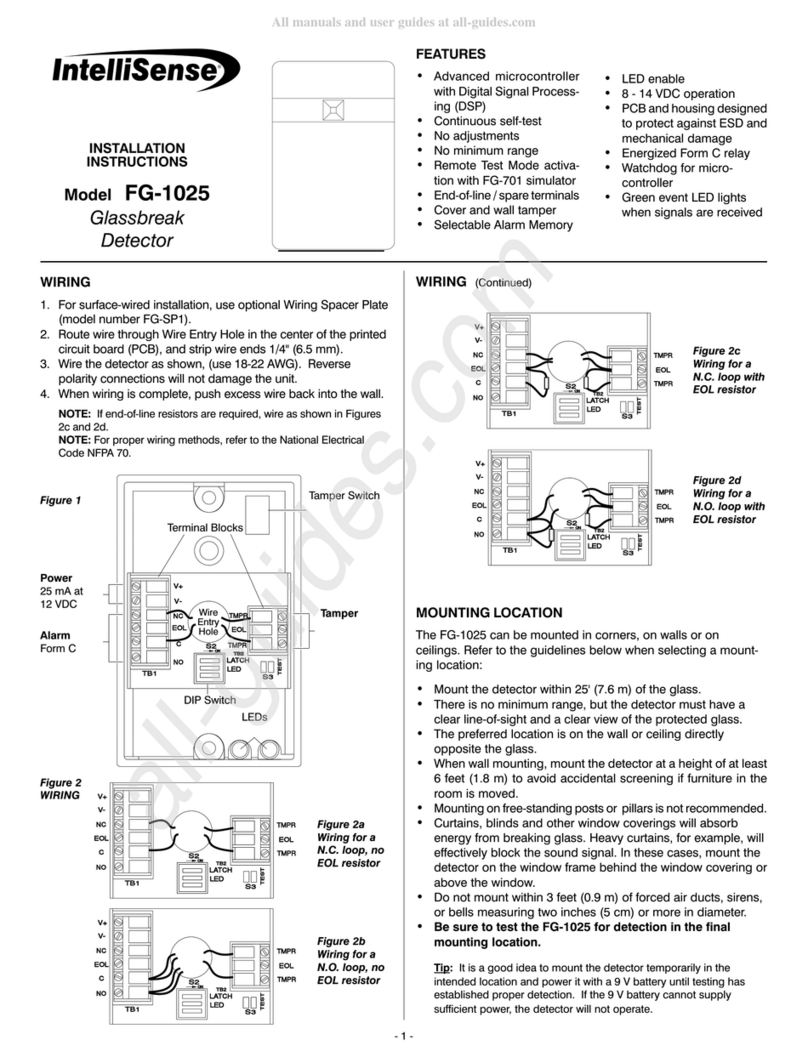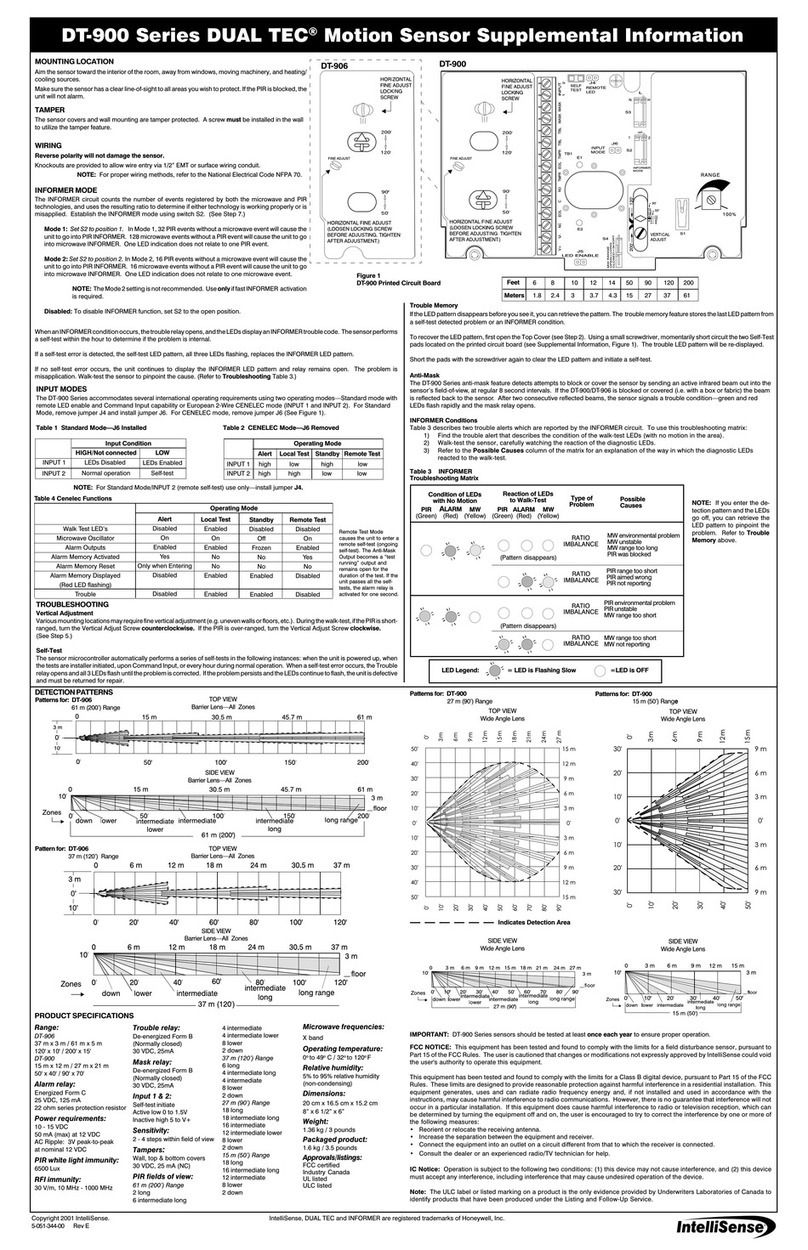
4
LED Indicators
The two LEDs shining through the front cover are used to
indicate the detector's operational status. The following table
summarizes the LED operation when the LEDs are enabled.
FCC Notice: This equipment has been tested and found to comply with the limits for a Class B digital device, pursuant to part 15 of the FCC Rules. These limits are designed to provide reasonable protection
against harmful interference in a residential installation. This equipment generates, uses and can radiate radio frequency energy, and if not installed and used in accordance with the instructions may cause
harmful interference to radio communications. However, there is no guarantee that interference will not occur in a particular installation. If this equipment does cause harmful interference to radio or television
reception, which can be determined by turning the equipment off and on, the user is encouraged to try to correct the interference by one or more of the following measures: 1) Reorient or relocate the receiving
antenna, 2) Increase the separation between the equipment and receiver, 3) Connect the equipment into an outlet on a circuit different from that to which the receiver is connected. The installer can also consult
an experienced radio/television technician for additional suggestions, if necessary.
In addition, a booklet on interference, prepared by the Federal Communications Commission, is also available for reference. Order "Inter ference Handbook" from the U.S. Government Printing Office,
Washington D.C. 20402, stock no. 0004-000-00450-7.
Copyright 1997 C&K Systems, Inc.
All Rights Reserved
http://www.cksys.com
5-051-436-00 Rev C
C&K is a registered trademark of C&K Components, Inc.
IntelliSense is a registered trademark of C&K Systems, Inc.
3M is a registered trademark and Scotchtint is a trademark of 3M Corporation.
Hardglass is a registered trademark of CHB Industries.
Normal, no event OFF OFF
Normal, event detected Flicker OFF
Normal, break detected OFF ON
Power-up self-test ON, one second ON, one second
Trouble detected Flash ON/OFF Flash OFF/ON
Test mode, no alarm Flash once per second OFF
Test mode, event detected Flicker OFF
Test mode, alarm Flash once per second ON
Condition Green LED Red LED
Self-Tests
The FG-1008 automatically performs a series of self-tests
during power-up, and continuously. If any self-test fails, the
detector will signal trouble by flashing the LEDs alternately
once per second. Protection will continue if possible. If the
trouble condition clears, the LEDs will return to the normal
state. Always return the detector for repair if there is any
indication of trouble, even if the trouble is temporary.
SPECIFICATIONS
Range:
8’(2.4m) maximum
No minimum range
Alarmrelay:
Form A, 250 mA maximum
25VDCmaximum
Alarm duration:
5 seconds (unaffected by alarm
LED latching)
Tamperswitch:
Cover tamper 25 mA maximum
24VDCmaximum
Powerrequirements:
8 - 14 VDC; 17 mA typical at
12VDC, 30 mA max.;
AC Ripple: 4 Volts peak to peak at
nominal 12 VDC
Operating temperature:
32°to120°F(0° to49°C)
Storage:-4°to122°F(-20°to50°C)
RFIimmunity:
30 V/m, 10 MHz - 1000 MHz
ESDimmunity:
10 kV, Discharges of either polarity
toexposed surfaces
Magneticcontact:
Makegap 0.9” minimum
Break gap 2.2” maximum
Dimensions:
Glassbreakhousing:
4-9/16”x15/16”x1-1/4”
(11.6 cm x 2.3 cm x 3.2 cm)
Magnethousing:
4-9/16”x15/16”x1/2”
(11.6 cm x 2.3 cm x 1.3 cm)
Weight:
2.9 oz., (81 g)
packaged product: 3.8 oz., (108 g)
Accessories:
FG-701 Glassbreak Simulator
Approvals/listings:
FCC verified
UL listed
POWER-UPSELF-TESTS
• RAMTest:Write&read allRAMlocations
withone’s &zero’s
• ArithmeticTest:Verifycorrectresultsfor
CPUarithmetic
• LogicTest:Verifycorrect resultsfordata
comparisons
• ClockRate Test:Checkclock frequencyby
measuringexternaltimeconstants
• ActiveAnalogCircuit Test: Injectsignals
intoanalog channelstocheck gains,filters,
A/D,andinterrupts
CONTINUOUSSELF-TESTS
• Watchdog:Supervises
microcontroller
• ROMChecksum:Firmware ROM
checksumverified
• RAMTest:Write& readRAM
locationswith one’s &zero’s
• LogicTest:Verifycorrectresultsfor
datacomparisons
• PassiveAnalogCircuitTest:Verify
analoginputs are withinnormal
bounds
Protected glass:
Minimum size for all types is 11" (28 cm) square; Glass must be framed in
the wall of the room or mounted in a barrier of 36" (0.9 m) minimum width.
1Laminated and sealed insulating glass types are protected only if both plates of the
glass are broken.
2For glass coated on the inner surface with 3M ScotchtintTM type RE35NEARL or Hardglass®
Security Film.
IMPORTANT: The FG-1008 must be connected to a UL listed power supply or UL listed
control unit capable of providing a minimum of four hours of standby power.
THICKNESS
Type Minimum Maximum
Plate 3/32" (2.4 mm) 1/4" (6.4 mm)
Tempered 1/8" (3.2 mm) 1/4" (6.4 mm)
Laminated11/8" (3.2 mm) 9/16" (14.3 mm)
Wired 1/4" (6.4 mm) 1/4" (6.4 mm)
Coated21/8" (3.2 mm) 1/4" (6.4 mm)
Sealed Insulating11/8" (3.2 mm) 1/4" (6.4 mm)
NOTE: The content of this manual has been
revised. For your convenience, dashed lines have
been added to the margins of this document to
note the locations of the changes.
